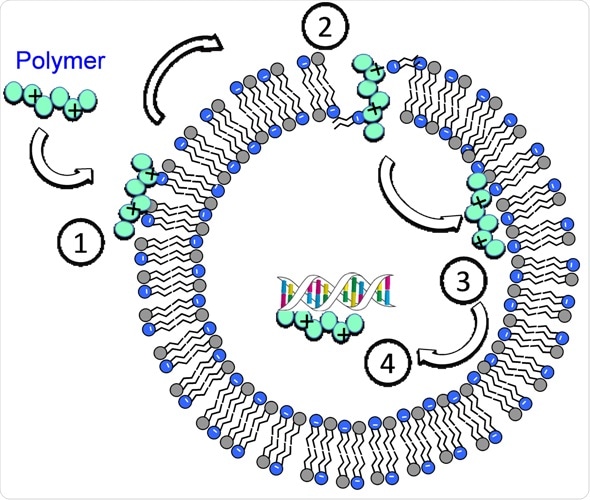Mar 7 2018
An international research team led by the Institute of Bioengineering and Nanotechnology (IBN) of the Agency for Science, Technology and Research (A*STAR) and IBM Research developed a synthetic molecule that can kill five deadly types of multidrug-resistant bacteria with limited, if any, side effects. Their new material could be developed into an antimicrobial drug to treat patients with antibiotic-resistant infections. This finding was reported in the scientific journal Nature Communications.

A diagram of the four-step killing mechanism of the polymer against drug-resistant superbugs: (1) binding of the positively charged polymer to the bacteria cell surface, (2) neutralizing the positive charges of the polymer to enter the bacterial cell membrane, (3) penetrating into the bacterial cyotoplasm, a fluid that fills the cell, and (4) precipitating the cytoplasmic substances to kill the bacterium.
Superbugs that are resistant to antibiotics are a serious health threat. According to the UK Review on Antimicrobial Resistance, superbugs kill around 700,000 people worldwide each year. By 2050, 10 million people could die each year if existing antibiotics continue to lose their effectiveness.
“There is an urgent global need for new antimicrobials that are effective against superbugs. The situation has become more acute because bacteria are starting to develop resistance to the last-line antibiotics, which are given only to patients infected with bacteria resistant to available antibiotics,” said Professor Jackie Y. Ying, Executive Director of IBN.
The research community is trying to develop alternatives to antibiotics using synthetic polymers. However, the antimicrobial polymers developed so far are either too toxic for clinical use, not biodegradable or can only target one type of bacteria.
To address this problem, Dr Yi Yan Yang from IBN brought together a multidisciplinary research team from the US, China and Singapore to develop a new class of antimicrobial polymers called guanidinium-functionalized polycarbonates with a unique killing mechanism that can target a broad range of multidrug-resistant bacteria. It is biodegradable and non-toxic to human cells.
The polymer kills bacteria in the following way. First, the polymer binds specifically to the bacterial cell. Then, the polymer is transported across the bacterial cell membrane into the cytoplasm, where it causes precipitation of the cell contents (proteins and genes), resulting in cell death.
The team tested the polymers on mice infected with five hard-to-treat multidrug-resistant bacteria: Acinetobacter baumannii, Escherichia coli, Klebsiella pneumoniae, methicillin-resistant Staphylococcus aureu and Pseudomonas aeruginosa. These superbugs are commonly acquired by patients in the hospitals and can cause systemic infections that lead to septic shock and multiple organ failure. The results showed that the bacteria were effectively removed from the mice and no toxicity was observed.
The researchers then further tested the effectiveness of the polymers on mice with two types of systemic infections caused by superbugs: peritonitis (an infection of the stomach’s inner lining) and lung infections from Pseudomonas aeruginosa. The polymers eliminated the bacterial infections in both groups of mice with negligible toxicity.
Dr Yi Yan Yang, Group Leader at IBN said:
We have demonstrated the first example of a biodegradable synthetic macromolecule with broad-spectrum antimicrobial activity in mice, unique killing mechanism and no toxicity. Once the polymer finishes its job of killing the bacteria, it will be naturally degraded after three days and will not remain in the body. This antimicrobial agent shows great promise for the treatment and prevention of multidrug-resistant systemic infections.
“This study illustrates the potential for this new research field we denote as ‘macromolecular therapeutics’ to create entirely new classes of treatments for multiple diseases,” said Dr James Hedrick, Distinguished Research Staff Member, IBM Research – Almaden, San Jose, California. “In 2016, we demonstrated the efficacy of synthetic polymers to combat deadly viral diseases. The current research for treating bacterial infections rounds out our ability to someday treat a spectrum of infectious diseases with a single, new type of mechanism without the onset of resistance.”
To determine whether the bacteria will develop any resistance to the polymer, the team collaborated with Dr Paola Florez de Sessions at A*STAR’s Genome Institute of Singapore and the Cell Engineering group of Dr Simone Bianco at IBM Research – Almaden to perform genomic analysis. They found that the bacteria did not show any resistance development even after multiple treatments with the polymer.